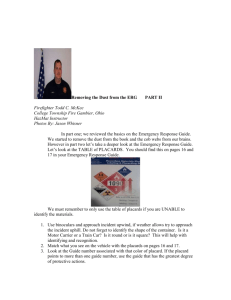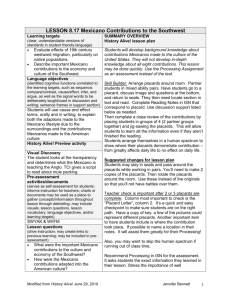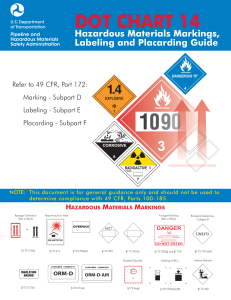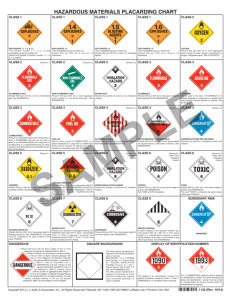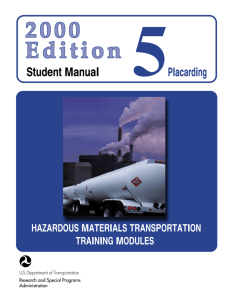PLACARDS, LABELS and OTHER MARKINGS (firefighters)
advertisement
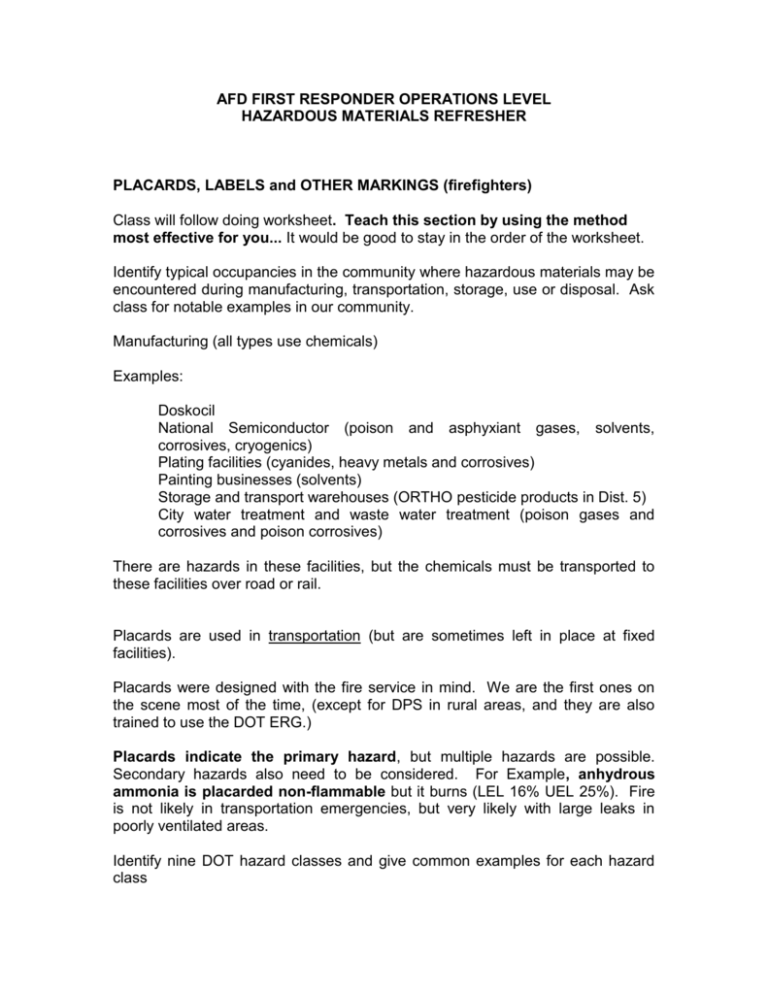
AFD FIRST RESPONDER OPERATIONS LEVEL HAZARDOUS MATERIALS REFRESHER PLACARDS, LABELS and OTHER MARKINGS (firefighters) Class will follow doing worksheet. Teach this section by using the method most effective for you... It would be good to stay in the order of the worksheet. Identify typical occupancies in the community where hazardous materials may be encountered during manufacturing, transportation, storage, use or disposal. Ask class for notable examples in our community. Manufacturing (all types use chemicals) Examples: Doskocil National Semiconductor (poison and asphyxiant gases, solvents, corrosives, cryogenics) Plating facilities (cyanides, heavy metals and corrosives) Painting businesses (solvents) Storage and transport warehouses (ORTHO pesticide products in Dist. 5) City water treatment and waste water treatment (poison gases and corrosives and poison corrosives) There are hazards in these facilities, but the chemicals must be transported to these facilities over road or rail. Placards are used in transportation (but are sometimes left in place at fixed facilities). Placards were designed with the fire service in mind. We are the first ones on the scene most of the time, (except for DPS in rural areas, and they are also trained to use the DOT ERG.) Placards indicate the primary hazard, but multiple hazards are possible. Secondary hazards also need to be considered. For Example, anhydrous ammonia is placarded non-flammable but it burns (LEL 16% UEL 25%). Fire is not likely in transportation emergencies, but very likely with large leaks in poorly ventilated areas. Identify nine DOT hazard classes and give common examples for each hazard class 1 2 3 4 5 6 7 8 9 Explosives, TNT, C4, etc Compressed gases, nitrogen, oxygen, etc Flammable and combustible liquids, gasoline etc Flammable solids and dangerous when wet, sodium metal Oxidizers and organic peroxides, Ammonium nitrate, MEK peroxide Poisons, pesticides, cyanides, etc Radioactive, alpha, beta or gamma sources Corrosives, caustic soda, sulfuric acid Miscellaneous hazardous materials, numerous wastes and products that don’t really fit in the other classes. Show placards with emphasis on hazard class numbers, colors, symbols, names and UN numbers. Create a table for them to list name, number, color(s) and symbol(s) # 1 2 2 2 2 3 4 4 Color orange red green white yellow red candy stripe white over red Symbol bursting ball flame cylinder skull x bones flaming O flame flame flame 4 5 5 6 6 7 8 9 Class Name explosives flammable gases non flammable toxic gases oxidizing gas flammable liquids flammable solids spontaneously combustible dangerous when wet oxidizers organic peroxides toxic (poison) infectious radioactive corrosive miscellaneous blue yellow yellow white label only yellow over white white over black black stripes over white flame (W) old flaming O flaming O skull X bones biohazard symbol propeller test tube hand/metal none N/A dangerous red with white band black lettering Discuss table 1 and table 2 materials. Table 1 materials must be placarded in all quantities. they are: Explosives 1.1, 1.2, 1.3 Poison gas 2.3 Dangerous when wet 4.3 Poison inhalation hazard 6.1 Radioactive (yellow III label only) Table 2 materials require a placard when the total weight of the material exceeds 1001 lbs. Bulk shipments usually have UN # in a white window on the placard. A dangerous placard can be used when multiple table 2 materials requiring placards are present, (up to 5000 lbs. loaded at one facility for each material) Dangerous placards (when used properly) identify mixed loads of table 2 materials. There should be no table 1 materials involved. DOT EMERGENCY RESPONSE GUIDEBOOK There are no visual aids to this section, just teach the book! Updated every three years. We are due for an update soon. Format has changed from 1993, more on that later. More accurately should be called the NAFTA emergency response guidebook, Mexico and Canada placards included. Inside front cover discusses shipping papers and their likely location. Locating these papers should be considered a priority in any transportation emergency involving vehicles that might contain hazardous materials. Just because a vehicle is not placarded, does not mean it doesn’t have HazMats on board. The shipping papers contain: Emergency contact number Proper shipping name of the material(s) 4 digit UN ID number The hazard class number The quantity by weight or volume For bulk shipments placards are shown with UN number in a placard window, or a placard with the UN number in an orange rectangle (more commonly seen in rail transportation. Page 1 has instructions-go over them. Page 2 is a quick reference of safety precautions Page 8 Discussion of “initial phase”. Also add that if chemicals are mixed or involved in fire the book may not be adequate. Use guide 111 in these instances. Book may not work well for fixed facility emergencies, especially indoors. HOW TO USE THE BOOK Example #1 UN # 1075 page 20 in yellow edged section guide number 115 (orange section) is indicated Potential hazards section The primary hazard is listed first. For propane it is fire hazard. In other guides the health hazard section is listed first. This section will help you estimate “the potential outcomes” of the incident. Fire and explosion hazards for propane are apparent to most firefighters, but under “public safety” the instructions are to isolate for 50 to 100 meters in all directions. This is the first thing that should be accomplished. Bear in mind a wider area may be advised as the incident progresses. Under protective clothing you find 1 wear scba (an emergency response requirement by SOP and NFPA) 2 structural firefighting gear will only provide limited protection... this is because these guides are generic for multiple chemicals and this guide may cover other chemicals that bunker gear is not rated for. If on fire read fire section If spill or leak and no fire read spill or leak section If you have victims read first aid section Be aware that there are multiple listings in the UN number section, do not stop at the first name you find by a UN number and use that entry for a positive chemical ID... Example: For UN 1993 the first entry (out of 13) is combustible liquid NOS...see the guide book for other possibilities. Using the Chemical name guide (blue pages) used the same way as the UN number guide Look up HYDROGEN FLUORIDE, anhydrous guide number 125 is listed but the name is highlighted Highlighted entries have extended isolation and protective action distances found in the green section Before using the green section you should have: 1 2 3 identified the material by ID number and name read the guide pages for that material notated the wind direction using the UN id (1052) number go to the green section (table of initial isolation and protective action distances) decide small or large spill...discuss the difference day or night...discuss the difference and why initial isolation distance and down wind protection the width of the plume is estimated as ½ the downwind protective action distance as shown on pages 298 and 299. compare the initial isolation distance in the table to the one in guide125 remember that the guide is generic and the green section is specific for the chemical. The green section overrides the orange section for protective action distances. Look up UN id number 1732 and discuss the considerations. THIS IS A MATERIAL that when released into water creates a (PIH) poison inhalation hazard by giving off hydrogen fluoride vapors. This requires the user to back track to develop initial isolation and protective action distance of .5 to 6.0 miles. NFPA 704M Powerpoint The NFPA 704M is used at fixed facilities and is sometimes seen on individual containers. UFC incorporates 704M but it is not enforced in Arlington. Companies that respond automatic or mutual aid to Fort Worth can expect to see it. 5 degrees of hazard The colors/hazards on the NFPA 704M system do not correspond with colors/hazards DOT placards. It uses 4 colors Red for relative flammability Blue for relative health hazard Yellow for relative reactivity (stability) White for special hazards BLUE-HEALTH A number of 2 or greater tells the firefighter that (in an emergency for that area) an SCBA is the minimum protection required. A number of three or greater requires specialized chemical protective clothing RED-FLAMMABILITY 4 is generally reserved for flammable gases, gasoline gets a three in this scheme. YELLOW-REACTIVITY More correctly called stability because this characteristic deals with selfreaction-not reaction with other chemicals. An example might be sensitive explosives with mass detonation hazard. This also incorporates water reactivity. A number 4 on reactivity with a W means that water may cause the chemical to become extremely unstable or cause toxic by products to be released. WHITE-SPECIAL HAZARDS SPECIAL HAZARDS ARE LISTED ON THE SLIDE
